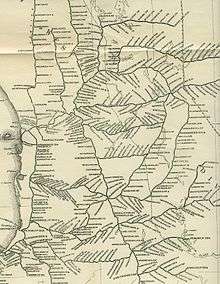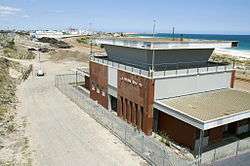Western Australian Government Railway lines and operations centres
Western Australian Government Railways railway system during its peak operational time in the 1930s to 1950s was a large system of over 4,000 miles of railway line.

Main lines
In rail administration, lines were given generic titles such as the Eastern Railway, the South Western, rather than after the destination.
- Metropolitan - ER - Eastern Railway - Suburban
- Bunbury - SWR - South Western Railway
- Kalgoorlie - EGR - Eastern Goldfields Railway
- Mullewa - NR - Northern Railway
- Leonora - EGR - Eastern Goldfields Railway
- Meekathara - NR - Northern Railway
- Esperance - EGR - Eastern Goldfields Railway
- Albany - GSR - Great Southern Railway
In different stages of the administration of the WAGR - the term for groups of railways were known by different terms [1]
Eastern Lines
- Eastern Railway - was known as Eastern Lines - started at Fremantle, and included other lines:
- Fremantle - Northam
- Fremantle - Jandakot - Armadale
- Robbs Jetty - Naval Base
- Bayswater - Belmont
- Bellevue - Helena Vale
- Bellevue - Mundaring - Mount Helena
- Mundaring - Mundaring Weir
- Clackline - Miling
Eastern Goldfields Lines
- Northam - Kalgoorlie - is also known as the Eastern Goldfields line - started at Northam, and included:
- East Northam - Wyalkatchem - Merredin
- Amery - Kalannie
- Burakin - Bonnie Rock
- Wyalkatchem - Mukinbudin - Southern Cross
- Coolgardie - Esperance
- Kalgoorlie - Leonora
- Malcolm - Laverton
- Kalgoorlie - Kamballie
South Western Lines
- Perth - Bunbury
- Collie - Collie Cardiff
- Pinjarra - Narrogin
- Brunswick Junction - Narrogin
- Bowelling - Wagin
- Donnybrook - Katanning
- Wonnerup - Nannup
- Picton Junction - Northcliffe
- Boyanup Junction - Flinders Bay
Southern Lines
- Spencers Brook - Albany
- York - Bruce Rock
- Brookton - Corrigin
- Narrogin - Merredin
- Yilliminning - Merredin
- Wagin - Newdegate
- Lake Grace - Hyden
- Katanning - Pingrup
- Tambellup - Ongerup
- Elleker - Nornalup
Northern Lines
- East Northam - Mullewa
- Geraldton - Wiluna
- Geraldton - Ajana
- Wokarina - Yuna
- Walkaway - Narngulu
- Cue - Big Bell
- Port Hedland - Marble Bar
Names of Lines and abbreviations
Names of lines were abbreviated regularly in WAGR publications - to facilitate List of Stations and Sidings on the Western Australian Government Railways open for Traffic sections in Goods rates books.[2][3] Also at one stage every location was numbered with a code number.
- B - Boulder Line
- B.B. - Boyanup - Busselton - Flinders Bay
- B.C. - Brookton - Corrigin
- B.N. - Brunswick Junction - Collie - Narrogin
- C.C. - Collie - Collie Cardiff
- C.E. - Coolgarie - Esperance
- C.M. - Clackline - Toodyay - Miling
- D. - Denmark Branch (Elleker - Nornalup)
- D.K. - Donnybrook - Katanning Section
- E.M. - East Northam - Wongan Hills - Mullewa
- E.R. - Eastern Railway (Fremantle - Northam)
- E.G.R. - Eastern Goldfields Railway (Northam - Cunderdin - Kalgoorlie)
- F.A. - Fremantle - Jandakot - Armadale
- G.A. - Geraldton - Northampton - Ajana
- G.M. - Goomalling - Merredin
- G.S.R. - Great Southern Railway (Spencers Brook - Albany)
- K.B.R. - Kalannie - Kulja - Bonnie Rock
- K.L. - Kalgoorlie - Laverton - Leonora
- K.P. - Katanning - Pingrup
- L.H. - Lake Grace - Hyden
- M. - Mundaring
- M.W. - Mundaring Weir
- N.K.M. - Narrogin - Kondinin - Merredin
- N.R. - Northern Railway (Geraldton - Wiluna)
- N.W.M. - Narrogin - Wickepin - Merredin
- P.P. - Picton Junction - Pemberton - Northcliffe
- P.M. - Port Hedland - Marble Bar
- P.N. - Pinjarra - Dwarda - Narrogin
- S.W.R. - South Western Railway (Perth - Bunbury)
- T.O. - Tambellup - Ongerup
- W.L.B. - Wagin - Newdegate
- W. - Walkaway Branch (Narngulu - Walkaway)
- W.B. - Wagin - Bowelling
- W.N. - Wonnerup - Nannup
- W.Y. - Wokarina - Yuna
- Y.B. - York - Quirading - Bruce Rock
Branches/sections
Internal WAGR publications usually identified railway lines as Lines, rather than as Branch Lines. Also tables and indexes of loads for locomotives created a large range of 'sections' that were either ganger related lengths, or related to gradients and conditions.
For a different way of identifying branches/routes see also Quinlan and Newland.[4]
- Ajana Branch
- Boulder Branch
- Brookton-Corrigin Branch
- Bullfinch Branch
- Bunbury to Katanning Branch
- Busselton Branch
- Collie to Brunswick Junction Branch
- Collie to Wagin Branch
- Denmark Branch
- Flinders Bay Branch
- Northampton Branch
- Hopetoun Railway
- Hotham Valley Branch
- Lake Brown Branch
- Lake Grace Branch
- Meekathara Branch
- Mundaring Branch
- Mundaring Weir Branch
- Nannup Branch
- Narembeen Branch
- Narrogin to Collie Branch
- Northcliffe Branch
- Ongerup Branch
- Pingrup Branch
- Pinjarra to Boddington Branch
- Port Hedland - Marble Bar Railway
- Sandstone Branch
- Toodyay Branch
- Upper Darling Range Branch
- Wiluna Branch
- Yuna Branch
Isolated lines
A number of isolated lines did not connect with the main rail systems - these included the Port Hedland - Marble Bar Railway and the Hopetoun - Ravensthorpe Railway. A number of piers were fitted with rail lines to carry goods from the ship to the mainland.
Operational centres

For most of the years that the WAGR existed as that entity, main offices, and divisional offices and buildings were all within a short range of Perth Railway Station. Rationalisation of the diverse addresses and locations occurred with the construction of the East Perth Head Office building.
- Head Office - East Perth
- Regional centres (current and historical)
- Workshops
- Fremantle Railway Workshops
- Midland Railway Workshops
- Marshalling yards - various yards have existed in the Perth Metropolitan area -
- Leighton
- Midland
- Kewdale
- South Fremantle (Robb Jetty).
- Grain silos (current and historical)
- Bellevue/Midland
- Fremantle,
- Kewdale
Notes
- ↑ The list relates to - The Goods Rates Book of 1 May 1951, similar to: - Western Australian Government Railways Commission (1953), Goods rates book, The Commission, retrieved 6 April 2013
- ↑ In some circumstances the rates books were not updated for a while..."New Railway Rates Book.". Western Mail (Perth, WA : 1885 - 1954). Perth, WA: National Library of Australia. 7 February 1935. p. 54. Retrieved 8 April 2013.
- ↑ In the 1951 Goods Rates Book (1 May 1951) further information in the lists include: Letter Code for each station in the system - for example A for Albany, AUG for Augusta; Station name; Line (abbreviationd found in this list); Cranes and Capacity - Number and Tons; Weighbridges and capacity - Number and Tons; Can Load and unload Carriages and Horses; Sheep and Cattle races; Warehouse accommodation; Shelter shed. Also each named located had a distinction as to whether it had platform or siding
- ↑
- Quinlan, Howard & Newland, John R. (2000) Australian Railway Routes 1854–2000 ISBN 0-909650-49-7